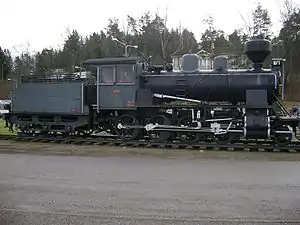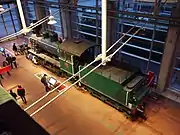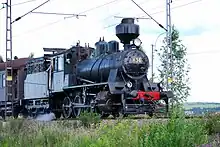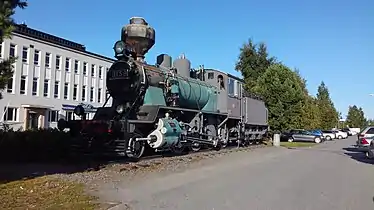VR Class Tk3
The Finnish VR Class Tk3 (original classification 'K5') was a 2-8-0 light freight locomotive. It was the most numerous steam locomotive class in Finland with 161 built. 100 locomotives were constructed between 1927 and 1930,[1] with a further 61 ordered and constructed 1943–53.[2] They were numbered 800–899, 1100–1118, and 1129–1170.
| VR Class Tk3 | |||||||||||||||||||||
|---|---|---|---|---|---|---|---|---|---|---|---|---|---|---|---|---|---|---|---|---|---|
 Tk3 with wood chimney | |||||||||||||||||||||
| |||||||||||||||||||||
| |||||||||||||||||||||
| |||||||||||||||||||||
| |||||||||||||||||||||
They were designed for a low axle load of just 10.7 tonnes (10.5 long tons; 11.8 short tons). This allowed them to operate on lightly laid secondary lines, but during their many years of service, up to the end of the steam era, they were also widely used on main lines hauling slow passenger trains that made frequent stops.
They were affectionately called "Pikku-Jumbo" (The Little Jumbo) because of their good performance despite their low weight. They had a low fuel consumption (usually Tk3s used birch wood) and good riding characteristics. They also had good steaming characteristics and were very popular among locomotive crews.
The livery of Tk3 was the same as other VR steam locomotives: dark locomotive green with a black smokebox. When new some locos were lined with thin gold decoration. The gold decorations were not repainted during maintenance, so they were seldom seen.
Two Tk3-type engines were originally supplied by Tampella to Rauma Rautatie as Nos. 9 and 10 (ex-No. 8) in 1935 and 1927 respectively. These engines became Tk3 1117 and 1118 after the private railway was absorbed by the State network in 1950.[1]
Preservation
Thirty-eight members of the class have been preserved:
- 852 Pieksämäki
- 859 Kouvola railway station, Kouvola
- 1100
- 1103 Retallack Leisure Centre & Holiday Park, Cornwall, UK.[3]
- 1104 Haapamäki
- 1105 Russian Railway Museum, Baltiysky railway station, St.Petersburg
- 1106 Parola
- 1108 Turku
- 1110
- 1111 Haapamäki
- 1112 Vaala
- 1129
- 1130 Haapamäki
- 1132 Porvoo
- 1134 Acton, Suffolk, England
- 1135 Haapamäki
- 1136 Haapamäki
- 1137
- 1138 Suolahti
- 1139 Haapamäki
- 1140 Tampere
- 1141
- 1142 Haapamäki
- 1144 Bressingham Steam and Gardens, England
- 1146 Haapamäki
- 1147 Rovaniemi
- 1148 Rovaniemi
- 1150 Suolahti
- 1151 England
- 1152 Ämmänsaari, Suomussalmi
- 1154 Commercial center Veturi, Kouvola, Tk3
- 1157 Acton, Suffolk, England
- 1159 Kokkola
- 1163 Pasila
- 1165 Seinäjoki
- 1167 Rauma, Finland
- 1168 Porvoo
- 1170 Karis
Gallery
 Tk 3 -class locomotive (most numerous steam locomotive class in Finland), in a commercial livery for the Sinebrychoff brewery (normal livery was black/forest green)
Tk 3 -class locomotive (most numerous steam locomotive class in Finland), in a commercial livery for the Sinebrychoff brewery (normal livery was black/forest green).jpg.webp) Tk 3 locomotive in a commercial livery
Tk 3 locomotive in a commercial livery.jpg.webp) Tk 3 locomotive in a commercial livery
Tk 3 locomotive in a commercial livery.jpg.webp) Tk 3 locomotive in a commercial livery
Tk 3 locomotive in a commercial livery
.jpg.webp) Tk3 1105 at Varshavsky Rail Terminal Museum, St.Petersburg, Russia
Tk3 1105 at Varshavsky Rail Terminal Museum, St.Petersburg, Russia.jpg.webp) Tk3 1105 at Varshavsky Rail Terminal Museum, St.Petersburg, Russia
Tk3 1105 at Varshavsky Rail Terminal Museum, St.Petersburg, Russia.jpg.webp) Tk3 1105 at Varshavsky Rail Terminal Museum, St.Petersburg, Russia
Tk3 1105 at Varshavsky Rail Terminal Museum, St.Petersburg, Russia.jpg.webp) Tk3 1105 at Varshavsky Rail Terminal Museum, St.Petersburg, Russia
Tk3 1105 at Varshavsky Rail Terminal Museum, St.Petersburg, Russia.jpg.webp) Tk3 1105 at Varshavsky Rail Terminal Museum, St.Petersburg, Russia
Tk3 1105 at Varshavsky Rail Terminal Museum, St.Petersburg, Russia.jpg.webp) Tk3 1105 at Varshavsky Rail Terminal Museum, St.Petersburg, Russia
Tk3 1105 at Varshavsky Rail Terminal Museum, St.Petersburg, Russia.jpg.webp) Tk3 1105 at Varshavsky Rail Terminal Museum, St.Petersburg, Russia
Tk3 1105 at Varshavsky Rail Terminal Museum, St.Petersburg, Russia.jpg.webp) Tk3 1105 at Varshavsky Rail Terminal Museum, St.Petersburg, Russia
Tk3 1105 at Varshavsky Rail Terminal Museum, St.Petersburg, Russia.jpg.webp) Tk3 1105 at Varshavsky Rail Terminal Museum, St.Petersburg, Russia
Tk3 1105 at Varshavsky Rail Terminal Museum, St.Petersburg, Russia.jpg.webp) Tk3 1105 at Varshavsky Rail Terminal Museum, St.Petersburg, Russia
Tk3 1105 at Varshavsky Rail Terminal Museum, St.Petersburg, Russia.jpg.webp) Tk3 1105 at Varshavsky Rail Terminal Museum, St.Petersburg, Russia
Tk3 1105 at Varshavsky Rail Terminal Museum, St.Petersburg, Russia.jpg.webp) Tk3 1105 at Varshavsky Rail Terminal Museum, St.Petersburg, Russia
Tk3 1105 at Varshavsky Rail Terminal Museum, St.Petersburg, Russia.jpg.webp) Tk3 1105 at Varshavsky Rail Terminal Museum, St.Petersburg, Russia
Tk3 1105 at Varshavsky Rail Terminal Museum, St.Petersburg, Russia.jpg.webp) Tk3 1105 at Varshavsky Rail Terminal Museum, St.Petersburg, Russia
Tk3 1105 at Varshavsky Rail Terminal Museum, St.Petersburg, Russia.jpg.webp) Tk3 1105 at Varshavsky Rail Terminal Museum, St.Petersburg, Russia
Tk3 1105 at Varshavsky Rail Terminal Museum, St.Petersburg, Russia.jpg.webp) Tk3 1105 at Varshavsky Rail Terminal Museum, St.Petersburg, Russia
Tk3 1105 at Varshavsky Rail Terminal Museum, St.Petersburg, Russia
 Tk3 steam locomotive in Helsinki
Tk3 steam locomotive in Helsinki preserved VR Class Tk3 steam locomotive (no. 1147) covered with snow at Rovaniemi railway station in Rovaniemi, Finland
preserved VR Class Tk3 steam locomotive (no. 1147) covered with snow at Rovaniemi railway station in Rovaniemi, Finland VR Class Tk3 1147 at Rovaniemi railway station
VR Class Tk3 1147 at Rovaniemi railway station Tk3 1151 at Ongar Station Epping Ongar Railway
Tk3 1151 at Ongar Station Epping Ongar Railway Tk3 1159 at Kokkola
Tk3 1159 at Kokkola.jpg.webp) Tk3 1168
Tk3 1168 Tk3 1170 at Karis
Tk3 1170 at Karis.jpg.webp) Tk3 1170 at Karis
Tk3 1170 at Karis.jpg.webp) Tk3 1170 at Karis
Tk3 1170 at Karis.jpg.webp) Tk3 1170 at Karis
Tk3 1170 at Karis Tk3 no1167 at Rauma Finland
Tk3 no1167 at Rauma Finland
See also
References
Literature
Valtionrautatiet 1937-1962, Helsinki 1962